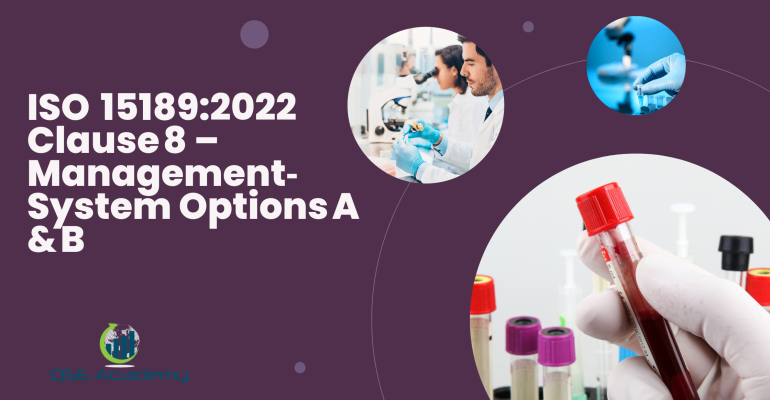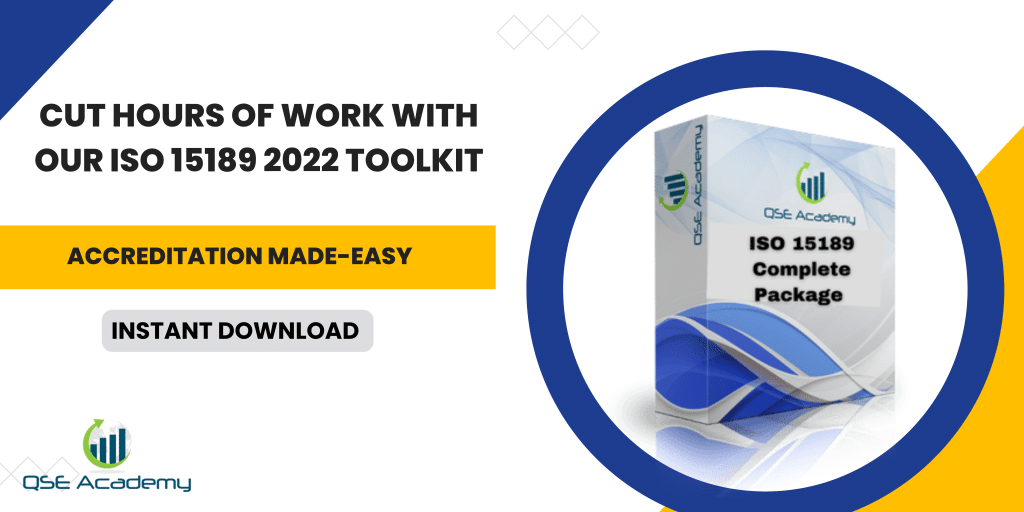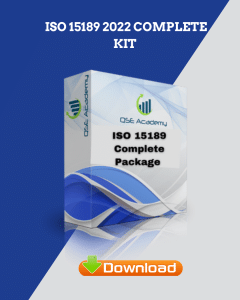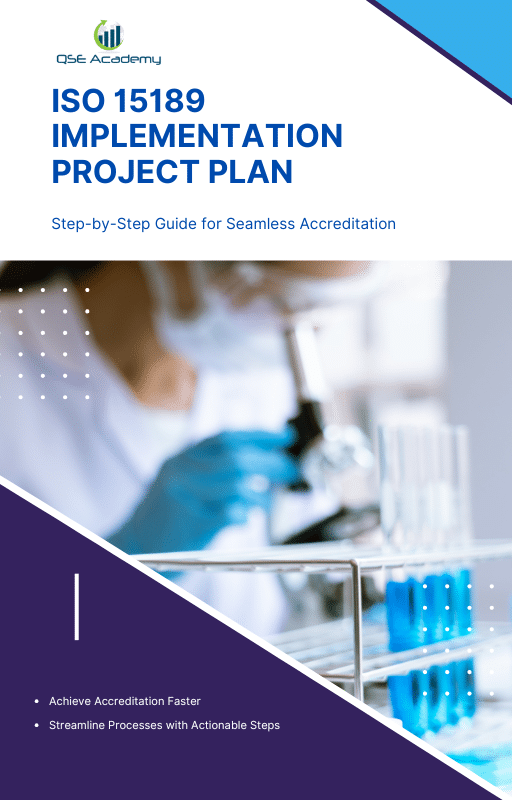ISO 15189:2022 Clause 8 – Management‑System Options A & B
Last Updated on October 22, 2025 by Hafsa J.
How Clause 8 Defines the Backbone of Laboratory Quality
When I help labs implement ISO 15189, Clause 8 is often the turning point. This is where everything—from policies to performance reviews—comes together into one coherent management system. It’s not just about ticking compliance boxes; it’s about creating a structure that keeps quality alive every single day.
Here’s what I’ve noticed: many labs excel at technical work but struggle to sustain consistency over time. Clause 8 fixes that. It gives your lab the framework to plan, check, and continually improve—all while keeping patient safety and data integrity at the center.
By the end of this guide, you’ll understand how Clause 8 works, what the difference is between Option A and Option B, and how to choose the one that fits your laboratory’s size, setup, and existing systems.
What ISO 15189 Clause 8 Covers – Why the Management System Matters
Clause 8 is the part of ISO 15189 that keeps your entire laboratory running smoothly. It’s the engine room of your quality system—the part that ensures all your procedures, responsibilities, and data don’t just exist, but work together seamlessly.
Here’s what this clause really covers:
-
Quality policy and objectives that define what excellence means for your lab.
-
Document and record control so you always know which version is current and who approved it.
-
Internal audits and management reviews to check whether your system is working as intended.
-
Corrective and preventive actions that make sure problems get solved for good.
-
Continual improvement mechanisms to keep quality moving forward, not just stable.
In short, Clause 8 ensures that your lab doesn’t drift into chaos as it grows or changes. Every standard—from Clause 4’s impartiality to Clause 7’s process control—depends on it.
Pro Tip: Think of Clause 8 as your lab’s “quality nervous system.” When it’s strong, every department moves in sync; when it’s weak, you see confusion, inconsistency, and recurring audit findings.
Common Pitfall: Treating the management system as a stack of documents. ISO 15189 expects an active system—one that’s reviewed, improved, and used daily by management and staff alike.
Option A – The ISO 15189-Only Management System
Option A is the straightforward route—it means your laboratory builds its entire quality management system (QMS) based solely on ISO 15189’s own requirements. No need to reference other standards like ISO 9001.
Here’s how it works: you follow the management system clauses already built into ISO 15189—covering documentation, internal audits, management reviews, risk management, and continual improvement. Everything you need is already in the standard.
This approach is perfect for smaller or independent labs that want to keep things simple and focused. You don’t need to interpret or merge frameworks—you just follow ISO 15189 directly and make sure every element is implemented consistently.
Here’s what it includes:
-
Quality policy and objectives – clearly state your lab’s commitment to patient care, accuracy, and competence.
-
Document and record control – manage every SOP, log, and record under version control.
-
Internal audits and corrective actions – use audits to spot weaknesses and drive improvement.
-
Management review – evaluate performance data and resource needs regularly.
-
Continual improvement – measure, analyze, and refine your system over time.
Pro Tip: Use a simple Quality Manual to connect all your procedures and forms back to ISO 15189 clauses. It makes navigation effortless for auditors and staff alike.
Example: I worked with a small diagnostics lab that chose Option A to keep things lean. Their QMS was built entirely on ISO 15189 templates, with short but precise procedures. They passed accreditation on their first attempt—because simplicity made consistency easy.
Option B – Integrated Management System Using ISO 9001 Principles
Option B is the more strategic route—it’s designed for laboratories that already operate under ISO 9001 or plan to integrate multiple standards into one system. Instead of building a separate ISO 15189 management system, you embed its requirements into your existing ISO 9001 framework.
Here’s what that looks like:
-
You use ISO 9001’s structure—context, leadership, planning, support, operation, performance evaluation, and improvement—as your base.
-
Then, you integrate all laboratory-specific ISO 15189 requirements like impartiality, confidentiality, equipment control, and test validation right into those same processes.
This option makes sense for hospital networks, large diagnostic groups, or multi-standard organizations that need a unified quality framework. It saves time, avoids duplicate documentation, and helps every department speak the same “quality language.”
Pro Tip: When using Option B, keep one management review and one audit schedule for all standards. That single-system approach shows efficiency and maturity—two things assessors respect.
Example: A regional hospital integrated its laboratory QMS into the hospital’s existing ISO 9001 system. By aligning objectives, audits, and risk management across all departments, they reduced overlapping documentation by 40 percent and made audits far more straightforward.
Common Mistake: Copy-pasting ISO 9001 templates without adapting them to the lab’s reality. ISO 15189 is more technical—your procedures must include specific controls for test methods, traceability, and result reporting.
Comparing Options A & B – Which One Fits Your Laboratory?
Choosing between Option A and Option B isn’t about which one is “better.” It’s about which one fits your lab’s setup, size, and maturity level. Both paths lead to accreditation—but they take slightly different routes.
Here’s the quick breakdown:
| Feature | Option A | Option B |
|---|---|---|
| Based on | ISO 15189 only | ISO 9001 integrated with ISO 15189 |
| Complexity | Lower – simple and self-contained | Higher – requires alignment between systems |
| Ideal for | Independent or smaller labs | Hospital or multi-standard organizations |
| Documentation | Stand-alone ISO 15189 QMS | Unified QMS with shared policies and audits |
| Advantages | Easier to set up and maintain | Reduces duplication, aligns with broader business processes |
| Challenges | May need expansion if lab grows or adds new standards | Requires strong documentation discipline and coordination |
Pro Tip: Choose the option that complements where your organization is today—not where you hope it’ll be someday. A simple, consistent Option A system often outperforms a poorly integrated Option B system.
Example: A private pathology lab started with Option A for focus and speed. When it later became part of a hospital network, it transitioned to Option B seamlessly—because its foundation was already strong.
Common Pitfall: Choosing Option B too early. Integration only works when your ISO 9001 system is mature enough to support the added technical depth of ISO 15189.
Implementing Option A – Step-by-Step Guide
If your lab is new to ISO standards, Option A is a great place to start. It’s clear, self-contained, and easy to maintain—especially for small or medium-sized laboratories that want control without complexity.
Here’s how to build your management system under Option A:
-
Develop a Quality Policy and Objectives.
Write a short, clear statement that defines your lab’s commitment to accuracy, impartiality, and patient safety. Then set measurable goals—like turnaround time targets, zero overdue calibrations, or improved sample traceability. -
Document and Control Your Procedures.
Every critical process—sample handling, testing, reporting, and maintenance—must have an approved SOP. Keep them version-controlled and easily accessible. -
Train and Authorize Staff.
Assign responsibilities clearly and ensure each staff member understands their authority level, from performing tests to releasing results. -
Conduct Internal Audits.
Plan regular audits to check whether procedures are being followed and records are complete. Use findings as learning opportunities, not just compliance checks. -
Hold Management Reviews.
At least once a year, review quality objectives, audit results, risks, and improvement actions. Document the meeting minutes and follow up on all decisions. -
Drive Continual Improvement.
Use trends, KPIs, and staff feedback to refine your system. Clause 8 expects evidence that your lab doesn’t just maintain quality—it improves it.
Pro Tip: Build a Quality Manual as your system roadmap. Keep it concise—link each ISO 15189 requirement to your specific procedures and forms. Assessors appreciate clarity over volume.
Example: A small clinical chemistry lab I worked with used a 30-page Quality Manual and digital SOPs. Their internal audit program caught minor errors early, saving them from costly findings during accreditation.
Implementing Option B – Step-by-Step Integration Plan
If your lab already runs under ISO 9001, Option B is the smarter path. It lets you build a single management system that meets both ISO 9001 and ISO 15189 requirements—no duplication, no confusion.
Here’s how to make that integration work:
-
Start with what you have.
Review your current ISO 9001 processes. Many already cover management review, document control, internal audits, and continual improvement. What’s missing are the laboratory-specific elements—method validation, impartiality, confidentiality, and technical competence. -
Map the standards.
Create a clause-comparison matrix between ISO 9001 and ISO 15189. This shows which requirements overlap and which need to be added. It’s your blueprint for integration. -
Adapt your procedures.
Insert lab-specific controls into your ISO 9001 framework. For example, extend your equipment maintenance SOPs to include calibration traceability, or add sample handling to your process-control procedures. -
Synchronize audits and reviews.
Run one internal audit program and one management review that cover both standards. It’s more efficient and gives leadership a unified view of performance and risk. -
Align your quality objectives.
Use shared goals—like turnaround time, accuracy, or incident reduction—that make sense across both business and laboratory functions.
Pro Tip: Maintain a single Integrated Management Manual that references both ISO 9001 and ISO 15189 clauses. It signals maturity and simplifies navigation during audits.
Example: A hospital laboratory I worked with integrated ISO 15189 into its hospital-wide ISO 9001 system. They eliminated nearly 50 duplicated procedures, standardized corrective-action tracking, and gained a clearer view of lab performance within the hospital’s broader quality dashboard.
Common Mistake: Copying ISO 9001 templates without tailoring them to laboratory realities. Remember—ISO 9001 manages business quality; ISO 15189 manages technical quality. Both must coexist, but not be identical.
Management Reviews and Continual Improvement
Clause 8 doesn’t just ask you to manage quality—it expects you to prove that leadership is actively steering it. Management reviews are how you do that. They turn your data, audit findings, and performance metrics into decisions that keep your lab improving year after year.
Here’s what a solid management review includes:
-
Inputs: Internal audit results, QC trends, complaints, staff feedback, proficiency testing, equipment performance, and improvement opportunities.
-
Discussion: Assess resource adequacy, risk levels, and whether the lab is meeting its quality objectives.
-
Outputs: Clear action items—like training needs, equipment upgrades, or process revisions—with assigned responsibilities and deadlines.
Pro Tip: Use a Management Review Tracker that links each discussion point to a follow-up action. When the next review comes around, you’ll have a clear record of progress and accountability.
Example: One lab I helped introduced a color-coded management review dashboard summarizing KPIs—turnaround times, QC pass rates, and staff training completion. It made leadership engagement visible and helped them spot early warning signs before issues escalated.
Common Pitfall: Holding management reviews just to “tick the box.” Assessors will always ask, “What decisions or improvements came out of your last review?” If you can’t show evidence of change, you’re missing the intent of Clause 8.
Continual Improvement Tip: Don’t wait for audits to drive change. Track trends monthly—QC shifts, repeated nonconformities, customer feedback—and act early. That’s how you turn compliance into real performance.
Documentation and Record Control under Clause 8
If Clause 8 is the backbone of your management system, document control is its nervous system—it connects everything and keeps your lab functioning smoothly. Without it, even the best processes fall apart.
Here’s what ISO 15189 expects:
-
Document Approval and Review: Every SOP, policy, and form must be reviewed, approved, and version-controlled. Outdated versions should be removed or clearly marked as “obsolete.”
-
Accessibility: The right people must have access to the right documents at the right time—whether digitally or in print.
-
Record Integrity: All quality records (logs, forms, reports) must be legible, traceable, and stored securely for the required retention period.
-
Change Control: Any change to documents must be reviewed and authorized. This ensures your procedures evolve under control, not chaos.
Pro Tip: Maintain a Document Master List—a single sheet that lists all controlled documents, their version numbers, owners, and next review dates. Assessors often start with this because it shows whether your system is organized or reactive.
Example: A molecular lab I worked with used to store SOPs across multiple computers and shared folders. During an audit, they couldn’t prove which version was current. After implementing a cloud-based document control system, retrieval time dropped from minutes to seconds, and their next audit had zero findings.
Common Pitfall: Treating recordkeeping as an afterthought. Auditors can forgive small formatting errors, but they won’t overlook missing records—especially for QC, calibration, or training.
Pro Tip (Bonus): Use color-coded or digital review stamps—green for active, red for obsolete, yellow for “under review.” It adds instant visual clarity during audits.
FAQs – ISO 15189 Clause 8 Management-System Options
Q1: What’s the main difference between Option A and Option B?
Option A means you build your management system purely around ISO 15189’s requirements—it’s self-contained and simpler. Option B means you integrate ISO 15189 into an existing ISO 9001 system, combining both standards into one unified framework.
Q2: Which option is better for my lab?
It depends on your setup. If you’re a stand-alone or specialized lab, Option A keeps things lean and focused. If you’re part of a hospital or already ISO 9001 certified, Option B saves time and aligns your lab with wider organizational goals.
Q3: Can I switch from Option A to Option B later?
Absolutely. Many labs start with Option A to get accredited faster, then shift to Option B once their organization grows or integrates other ISO standards. Just make sure the transition is clearly documented.
Q4: Which option do accreditation bodies prefer?
Neither. Assessors only care about effectiveness and compliance. Whether you choose A or B, what matters is that your management system consistently ensures competence, impartiality, and improvement.
Q5: What are the most common Clause 8 audit findings?
Missing document control, outdated management reviews, and weak follow-up on corrective actions. Assessors look for evidence of use—not just well-written policies.
Build a System That Fits and Scales
Clause 8 is more than a compliance checklist—it’s the part of ISO 15189 that keeps your lab running efficiently long after accreditation. Whether you choose Option A or Option B, the goal is the same: a management system that’s practical, traceable, and built to improve over time.
Here’s what I’ve seen in successful labs:
-
They treat management reviews and internal audits as learning tools, not formalities.
-
Their documentation system is clean, current, and easy to navigate.
-
Leadership doesn’t just approve policies—they use them to make informed, evidence-based decisions.
If you get Clause 8 right, everything else in your quality system falls into place. Your processes stay consistent, your team stays aligned, and your results stay trusted.
So, choose the option that fits your reality today—but design it to grow with you tomorrow.
Next Step: Download QSE Academy’s ISO 15189:2022 Clause 8 Management-System Toolkit—complete with ready-to-use templates for quality policies, management review agendas, audit schedules, and document-control trackers to help your lab stay compliant, confident, and audit-ready year-round.
Whether it’s ISO 9001, ISO 22000, or the cosmetics-focused ISO 22716, I’ve spent my career I’m not here to call myself an expert—I prefer “enthusiast” because I truly love what I do. When I’m not writing about standards, you’ll probably find me playing Piano 🎹, connecting with people, or diving into my next big project💫. I’m an engineer specialized in the food and agricultural industry
make ISO standards less intimidating and more approachable for everyone.
turning complex jargon into clear, actionable steps that businesses can actually use.
There’s something incredibly rewarding about helping people navigate food safety and quality management systems
in a way that feels simple, practical, and even enjoyable.
I have a Master’s in QHSE management and over 12 years of experience as a Quality Manager
I’ve helped more than 15 companies implement ISO 9001, ISO 22000, ISO 22716, GMP, and other standards
My clients include food producers, cosmetics manufacturers, laboratories, and service companies
I believe quality systems should be simple, useful, and efficient.













